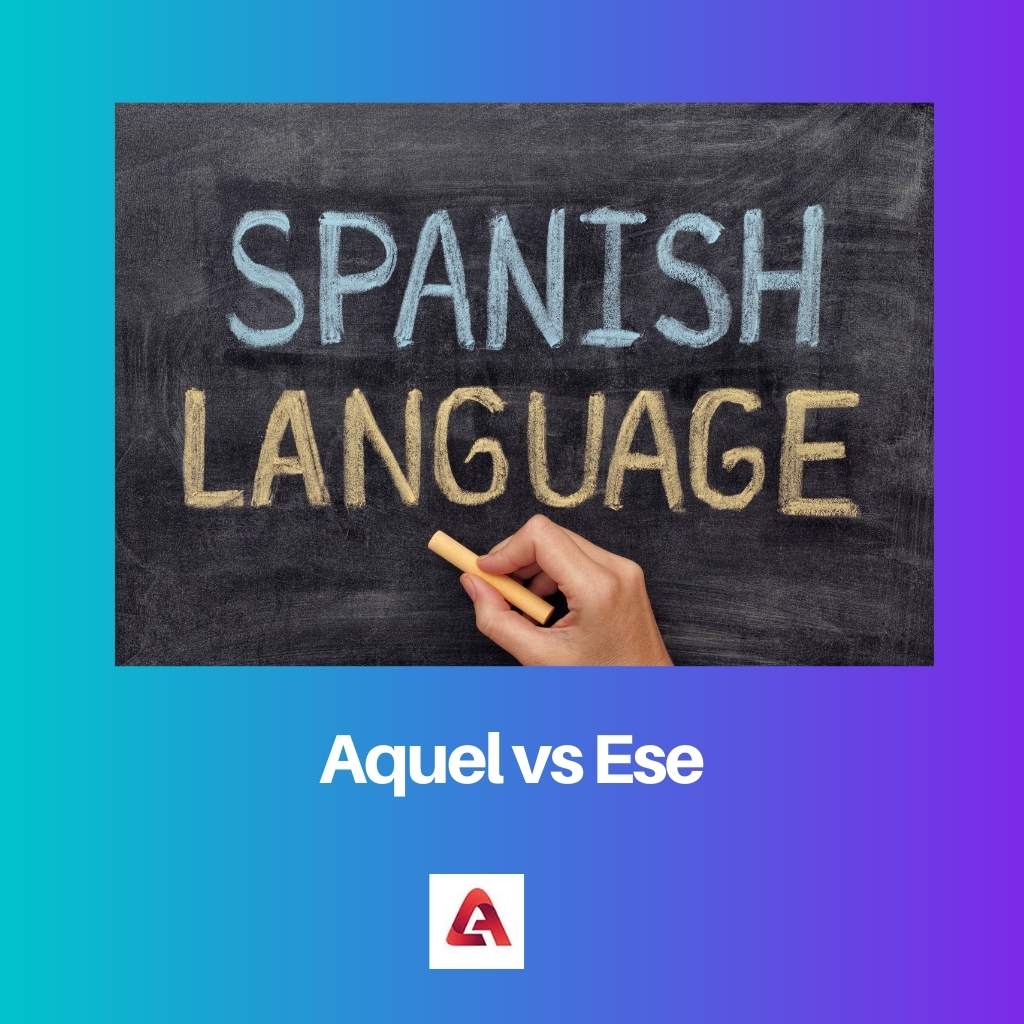The Spanish language has its own pronouns and types. Some of them include Direct object pronouns, possessive pronouns, and subject pronouns.
One such includes demonstrative pronouns. Aquel and Ese are both pronouns used in the Spanish language, which are confused among each other’s meanings by students learning this language.
They both refer to a class of demonstrative pronouns, which means it represents a noun concerning its positioning over there.
To highlight or mention the noun in an exclamatory sentence and reminiscing sentences that speak about cherishable and joyful past life and are commonly used to comment on something or simply comments.
Key Takeaways
- Aquel refers to something far away from both the speaker and the listener, while ese refers to something near the listener but far from the speaker.
- Aquel is used to refer to something that has already been mentioned or is familiar to both the speaker and the listener, while ese is used to refer to something that is being introduced.
- Aquel is more formal than ese, which is more commonly used in informal situations.
Aquel vs Ese
Aquel refers to something far from both the speaker and the listener and refers to objects or ideas that are farther away in space or time. Ese refers to something that is closer to the listener than to the speaker and is used to refer to objects that are closer to the listener.

Aquel is used to mention an object far from their spot or to point to an object nearby that is visible. The object’s closeness in comparison with the listener and speaker is unsaid or unknown in the usage of Aquel.
So, this word is highly used in sentences that are in the past tense.
Ese is used to mention something that includes a person or an object in the visible region. The object’s place and visibility are made clear when said.
So, Ese is used in sentences that are of the present tense. The object’s closeness in comparison with the listener and speaker is in some way clear or mostly mentioned in the usage of Ese.
Comparison Table
| Parameters of comparison | Aquel | Ese |
|---|---|---|
| Types of Pronoun | Used in places where the sentence emphasises a demonstrative word. | Used in places where the sentence emphasises some demonstrative activity. |
| Word’s usage purpose. | It is used to speak with relevance to objects that are neither closer to the listener and nor closer to the speaker. | It is used to speak with relevance to the object’s position is known to both the listener and the speaker. |
| Situation based Application | It is used in a sentence that speaks about a situation where the scene has ended or over. | It is used in a sentence that speaks about a situation that mentions the situation at a recent time or something that is still prolonging. |
| Uses | It is used in almost all kinds of sentences. | It is only used with comments and exclamatory sentences. |
| Tense | It is used to represent a sentence that belongs to the past tense. | It is used to represent a sentence that belongs to the present tense. |
What is Aquel?
Aquel is a pronoun that mentions an object’s presence nearby or ‘over there in the Spanish language. Taking a sentence ‘Creo que conozco a aquella persona.’
In concern points to judge by looking at this sentence is that the sentence is being told to a girl, the time period may be a past sequence, and the object referred to in this sentence here is far away or a bit far from the speaker.
The reason behind each mention of the sentence is said in the different sections of this article.
This makes the usage of Aquel elegant in Spanish sentences and adds a lot of information about the sentence to give a clear idea about what is being said, who it is said to, and why the listener is using it.
It is bought to use with all types of sentences. This is used in places where the sentence emphasizes a demonstrative word.

What is Ese?
Ese is a word or a pronoun used in Spanish where it mentions something or someone or ‘that one’ in a better sense. Let’s consider the same under a sentence for better understanding.
In this sentence, ‘Esa Botella de vino es cara.’ ESA makes us understand that the sentence is being said to a girl, the time period may refer to something of the present scenario, and the object is being pointed out to the listener.
It is used in places where the sentence emphasizes some demonstrative activity. It is used to speak about the relevance with respect object’s position.
Here, the position is known to both the listener and the speaker. It is used with sentences that belong to the set of exclamatory sentences and comments.
It is used to represent a sentence that belongs to the present tense and is used in a sentence that speaks about a situation that mentions a recent time scenario which is something that is still prolonging.

Main Differences Between Aquel and Ese
- Aquel is used to refer to something which may be neither closer to the speaker nor closer to the listener, whereas Ese is used to refer to something whose position may be accurately known. This makes an important difference between them for the listener to understand the closer or closer the object’s location to precision.
- In usage or choice of time in the text, Aquel is used to describe a past concept whereas, Ese is used to refer to a more recent concept. So, the tense used in the sentence is made easier to understand by means of this word’s usage.
- Ese is used to ensure the accuracy is maintained when the subject in the sentence turns to be a predicate, whereas, Aquel doesn’t mention the position’s accuracy via sentences. This is not the case with the usage of Aquel in the sentence of a similar case. This is because the noun used needs a pronoun of descriptive type to explain the object under such circumstances.
- Aquel varies according to the sentence used with respect to the object’s proximities (how approximately near or far it is from the speaker or the listener), whereas Ese doesn’t vary proximities.
- Aquel becomes Aquella, whereas ese becomes esa. This is because the Spanish language is gender-sensitive, which means it uses slighter variations in the word, enabling us to understand the gender of the sentence it is being conveyed to. When used to female in the sentence.
- Aquel becomes Aquello, whereas Ese becomes Eso when the sentence is used to a neutral gender person. This usage makes the listener clear that it is said with nothing concerned about gender, and the point lets us know about the abstract idea being concentrated or spoken there.
- https://dspace.tul.cz/handle/15240/32410
- https://books.google.com/books?hl=en&lr=&id=cVILCPFD7CAC&oi=fnd&pg=PA5&dq=aquel+and+ese&ots=qI__6zjaZn&sig=ZPERc_fGqLfRCKR4E0oeS_S6Ims

Aquel and Ese are both demonstrative pronouns in Spanish, but they have different uses and situations in which we should use them. Understanding the difference is important for learners of the language as well as for those who wish to communicate effectively in Spanish.
The comparison table provided in the article is very helpful in understanding the nuances of using Aquel and Ese in the Spanish language.
I agree, these differences are crucial to understand the context of a conversation in Spanish.
The difference in usage of Aquel and Ese in terms of the past and present tense is an important aspect highlighted in the article.
Absolutely, understanding the tense and purpose associated with using these pronouns provides clarity and precision in communication.
The situational application for Aquel and Ese based on the type of sentence is also very insightful, as mentioned in the comparison table.
The clarity on the specific uses and applications of Aquel and Ese is beneficial for anyone aiming to communicate effectively in Spanish, especially in different conversational contexts.
Understanding the specific contexts and purposes for selecting Aquel or Ese in conversations is crucial, and this article elaborates on these details effectively.
The detailed explanation of both Aquel and Ese along with their usage in sentences helps learners of Spanish to grasp the context and application of these pronouns effectively.
The article also emphasizes the importance of understanding the tense and purpose for using Aquel and Ese, which is quite informative.
The usage of Aquel in sentences related to the past tense and Ese in sentences related to the present tense is a notable distinction discussed in the article.
Understanding the time-frame and context for using each pronoun is crucial for effective communication in Spanish.
The application of Aquel and Ese is well-explained in the article, along with the significance of the pronouns in different contexts. Learners of Spanish will find this content valuable.
The article effectively explains the practical usage and nuances of time-based and spatial-based referencing with Aquel and Ese, which is informative for language learners.
The detailed insights into the situational context for using these pronouns enhance the understanding of their application in the Spanish language.
The article provides a clear explanation of the differences between ‘Aquel’ and ‘Ese’. It’s interesting to see how the context, position, and use of these pronouns are affected by the speaker and listener.
Absolutely, the distinction between the two pronouns becomes quite clear from the details provided in the content.
The examples used in the article to illustrate the usage of Aquel and Ese are very effective in understanding their meaning and application.
The article presents a comprehensive comparison and explanation of Aquel and Ese, making it easier for learners to recognize and accurately use these pronouns in different Spanish sentences.
The detailed breakdown of the uses and applicability of Aquel and Ese in different conversational scenarios is quite instructive and valuable.
The distinctions between Aquel and Ese, especially in terms of formality and context, are essential to convey precise meanings in Spanish sentences.
The article provides a comprehensive understanding of the uses and applications of Aquel and Ese, contributing to accurate and contextual communication.